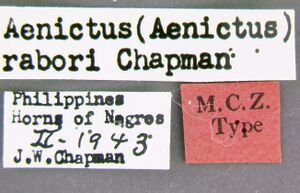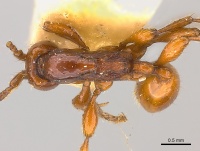Aenictus rabori
| Aenictus rabori | |
|---|---|

| |
| Scientific classification | |
| Kingdom: | Animalia |
| Phylum: | Arthropoda |
| Class: | Insecta |
| Order: | Hymenoptera |
| Family: | Formicidae |
| Subfamily: | Dorylinae |
| Genus: | Aenictus |
| Species: | A. rabori |
| Binomial name | |
| Aenictus rabori Chapman, 1963 | |
A. rabori is known only from the type locality. The colony observed by Chapman was foraging in a garden at 1,080 m in elevation (Chapman 1963).
Identification
A member of the philippinensis species group. This species is closely related to Aenictus pangantihoni. See under A. pangantihoni for details.
Keys including this Species
Distribution
Philippines (Negros Island)
Latitudinal Distribution Pattern
Latitudinal Range: 12.766089° to 9.333333°.
| North Temperate |
North Subtropical |
Tropical | South Subtropical |
South Temperate |
- Source: AntMaps
Distribution based on Regional Taxon Lists
Indo-Australian Region: Philippines (type locality).
Distribution based on AntMaps
Distribution based on AntWeb specimens
Check data from AntWeb
Countries Occupied
| Number of countries occupied by this species based on AntWiki Regional Taxon Lists. In general, fewer countries occupied indicates a narrower range, while more countries indicates a more widespread species. |

|
Estimated Abundance
| Relative abundance based on number of AntMaps records per species (this species within the purple bar). Fewer records (to the left) indicates a less abundant/encountered species while more records (to the right) indicates more abundant/encountered species. |

|
Biology
|
Castes
Known only from the worker caste.
   
| |
| . | Owned by Museum of Comparative Zoology. |
Nomenclature
The following information is derived from Barry Bolton's Online Catalogue of the Ants of the World.
- rabori. Aenictus (Aenictus) rabori Chapman, 1963: 249, fig. 2 (w.) PHILIPPINES (Negros).
- [Note: fig. 1, not fig. 2 as published.]
- Type-material: lectotype worker (by designation of Jaitrong & Yamane, 2012: 74), 8 paralectotype workers.
- Type-locality: lectotype Philippines: Negros, Cuernos de Negros, 3600 ft, 29.vii.1943 (J.W. Chapman); paralectotypes with same data.
- Type-depository: MCZC.
- Status as species: Wilson, 1964a: 476; Bolton, 1995b: 60; Jaitrong & Yamane, 2012: 74 (redescription).
- Distribution: Philippines (Negros).
Unless otherwise noted the text for the remainder of this section is reported from the publication that includes the original description.
Description
Worker
Wilson (1964) - Syntypes: Worker selected at random: HW 0.78 mm, HL 0.83 mm, SL 0.62 mm; HW of remainder of long syntype series 0.82-0.84 mm. Antenna 10-segmented. Mandibles typical. Clypeus convex, entire unarmed. Parafrontal ridge about 0.17 mm. Occiput very feebly convex, lacking distinct collar. Mesonotum demarcated from mesopleuron by a conspicuous ridge; a striking character shared within the genus only by the sympatric philippinensis. In addition, mesonotum drops to metanotum through a short vertical face; this character is peculiar to rabori. Unlike rabori, metanotum is level with basal face of propodeum. Femora and tibiae distinctly thicker than in philippinensis. Propodeal junction acutely angulate. Subpetiolar process almost non-existent, consisting at most of a very low central convexity. Pilosity moderately abundant; length of longest pronotal hairs 0.15 mm.
Entire head shining. Pronotal dorsum shining; remainder of mesosoma microreticulate and opaque. Pedicel microreticulate, its dorsum shining; remainder subopaque. Color as in philippinensis.
Jaitrong & Yamane (2012) - Lectotype: TL 4.50 mm; HL 0.85 mm; HW 0.83 mm; SL 0.65 mm; ML 1.48 mm; PL 0.35 mm; CI 97; SI 79.
Paralectotype (n = 8): TL 4.35-4.45 mm; HL 0.83-0.88 mm; HW 0.78-0.83 mm; SL 0.63-0.65 mm; ML 1.48-1.50 mm; PL 0.35-0.38 mm; CI 94-97; SI 76-79.
Head in full-face view slightly longer than broad, with sides convex and posterior margin nearly straight, very weakly sinuate; occipital margin bearing a distinct carina; occipital corner of head with a protruding lobe (part of occipital carina). Antennal scape relatively short, reaching only 2/3 of head length; antennal segment II slightly longer than each of III-VI; terminal segment slightly shorter than VII+VIII+IX. Frontal carinae short fused at the level of antennal base to form a single carina and much extending beyond the level of the posterior margin of torulus, poorly developed in posterior half. Parafrontal ridge short, extending less than 1/3 of head length, 0.25-0.27 mm long, seen in profile weakly developed in posterior half. Masticatory margin of mandible with a large apical tooth followed by a series of 4-5 denticles, which gradually reduce in size toward basal angle of mandible. Promesonotum in profile weakly convex dorsally and sloping gradually to metanotal groove; metanotal groove distinct and deep; upper portion of meso- and meta-pleuron impressed, much lower than promesonotum. Declivity of propodeum shallowly concave, encircled with a distinct rim that protrudes posteriad. Petiole subsessile, distinctly longer than high; subpetiolar process almost absent; postpetiole slightly shorter than petiole and almost as long as high, with its node rounded dorsally. Legs relatively short, seen from side with greatly swollen femora.
Head entirely smooth and shiny, except for hair pits, area on the side of head anterior to occipital corner with superficial reticulation; mandible extensively smooth and shiny except for hair pits; antennal scape superficially shagreened. Pronotum smooth and shiny, except for its anteriormost portion reticulate, narrow lateral margins distinctly reticulate, reaching back to posterior margin; mesonotum smooth and shiny; mesopleuron, metapleuron and propodeum densely punctuate/reticulate mixed with some rugae, mat except antero-ventral parts of meso- and metapleuron slightly shiny. Petiole microreticulate with dorsum more weakly sculptured; dorsum of postpetiole extensively smooth and shiny but other parts more or less reticulate. Femora entirely superficially reticulate and shiny; tibiae superficially shagreened partly smooth and shiny.
Head and mesosoma dorsally with relatively sparse long standing hairs; longest pronotal hair 0.25-0.27 mm long. Head, antennae, legs, and gaster yellowish brown; mandible, mesosoma, petiole, and postpetiole reddish brown.
Type Material
Jaitrong & Yamane (2012) - Nine syntype workers (two on each of three pins, three on another) from Philippines, Negros, Horns of Negros, 1,080 m (Museum of Comparative Zoology, examined). One worker among them (top on a pin) is selected as lectotype.
References
- Chapman, J. W. 1963. Some new and interesting Philippine ants (Hymenoptera: Formicidae). Philipp. J. Sci. 92: 247-263. (page 249, fig. 2 worker described)
- Jaitrong, W. & Yamane, S. (2012) Review of the Southeast Asian species of the Aenictus javanus and Aenictus philippinensis species groups (Hymenoptera, Formicidae, Aenictinae). ZooKeys 193: 49–78, doi: 10.3897/zookeys.193.2768.
- Wilson, E. O. 1964a. The true army ants of the Indo-Australian area (Hymenoptera: Formicidae: Dorylinae). Pac. Insects 6: 427-483 (page 476, see also)
References based on Global Ant Biodiversity Informatics
- Borowiec M. L. 2016. Generic revision of the ant subfamily Dorylinae (Hymenoptera, Formicidae). ZooKeys 608: 1–280.
- Chapman J. W. 1965. Studies on the ecology of the army ants of the Philippines genus Aenictus Schuckard (Hymenoptera: Formicidae). Philippine Journal of Science. 93: 551-595.
- Jaitrong W., and S. Yamane. 2012. Review of the Southeast Asian species of the Aenictus javanus and Aenictus philippinensis species groups (Hymenoptera, Formicidae, Aenictinae). ZooKeys 193: 49-78.
- Jaitrong, W., and S. Yamane. "Review of the Southeast Asian species of the Aenictus javanus and Aenictus philippinensis species groups (Hymenoptera, Formicidae, Aenictinae)." ZooKeys 193 (2012): 49-78.


